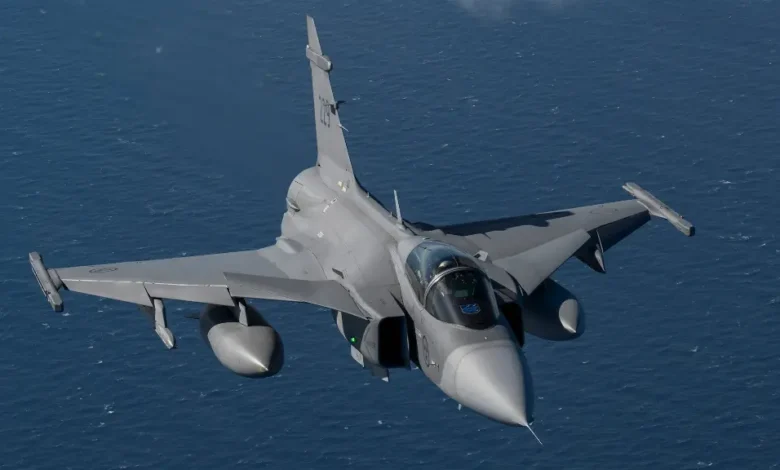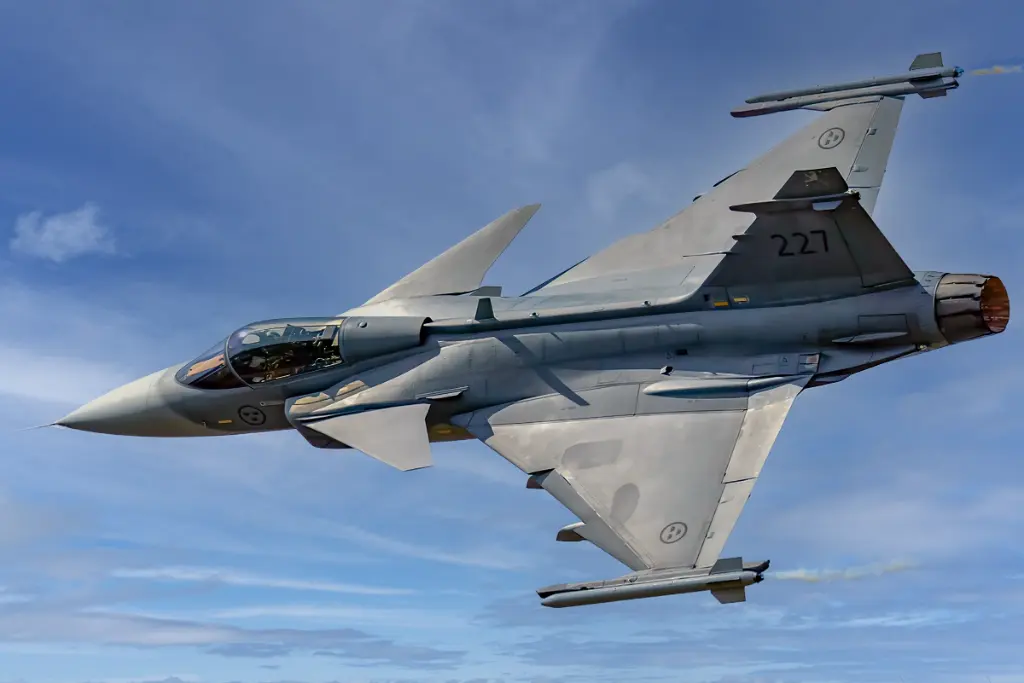Saab JAS 39 Gripen

The Saab JAS 39 Gripen is a lightweight, single-engine multirole fighter aircraft developed by Saab for the Swedish Air Force. First flown in 1988 and introduced in 1996, the Gripen is designed for air superiority, ground attack, and reconnaissance missions. Known for its agility, advanced avionics, and cost-effectiveness, the Gripen is widely exported and continuously upgraded to meet modern combat requirements.
Fact Sheet
| Role | Multirole fighter |
|---|---|
| Manufacturer | Saab |
| First Flight | 1988 |
| Service Entry | 1996 |
| Crew | 1 (Gripen C) or 2 (Gripen D) |
Specifications
| Length | 14.1 m (46 ft 3 in) |
|---|---|
| Wingspan | 8.4 m (27 ft 7 in) |
| Height | 4.5 m (14 ft 9 in) |
| Empty Weight | 6,800 kg (15,000 lb) |
| Max Takeoff Weight | 16,500 kg (36,400 lb) |
| Powerplant | 1 × Volvo RM12 turbofan |
| Thrust | 18,100 lbf (80.5 kN) with afterburner |
| Max Speed | Mach 2.0 (2,470 km/h; 1,535 mph) |
| Service Ceiling | 16,000 m (52,500 ft) |
| Range | 1,600 mi (2,592 km) ferry range |
| Rate of Climb | ~50,000 ft/min (254 m/s) |
Avionics & Armament
| Main Radar | PS-05/A radar |
|---|---|
| Avionics | Advanced avionics suite, electronic warfare systems |
| Armament | One 27-mm Mauser BK-27 cannon; Up to 8 external hardpoints for: – Air-to-air missiles (AIM-120 AMRAAM, IRIS-T) – Air-to-ground munitions (bombs, rockets) – Precision-guided bombs – External fuel tanks |
Notable Features
- Agile and lightweight design for superior maneuverability.
- Multirole capability for air-to-air and air-to-ground missions.
- Cost-effective solution for modern air forces.
- Advanced avionics for superior situational awareness.
- Widely exported to allied nations and continuously upgraded.

The Saab JAS 39 Gripen (Swedish: Gripen – “Griffin”) is a light, single-engine, multirole fighter aircraft manufactured by the Swedish aerospace and defense company Saab AB. It stands out in the global fighter market for its cost-effectiveness, high performance, and unique design philosophy rooted in Sweden’s specific defense needs.
Development and Design Philosophy
The Gripen’s development began in the early 1980s when the Swedish government sought to replace its aging fleets of Saab 35 Draken and Saab 37 Viggen aircraft. The requirement was for a single aircraft type capable of performing Jakt (fighter), Attack (attack), and Spaning (reconnaissance) missions – hence the “JAS” designation. A key aspect of the Swedish defense doctrine was the ability to operate from dispersed, short road strips (dispersed base operations), requiring STOL (short takeoff and landing) capabilities and rapid turnaround times by small ground crews.
The first prototype of the JAS 39 Gripen flew on December 9, 1988. Despite some early flight control software issues that led to a couple of crashes during testing, these were resolved, and the aircraft entered service with the Swedish Air Force in 1996.
Key Design Features and Capabilities
The Gripen’s design prioritizes agility, efficiency, and adaptability:
- Canard-Delta Wing Configuration: Similar to the Eurofighter Typhoon and Dassault Rafale, the Gripen uses a canard-delta wing layout. This provides excellent maneuverability across the flight envelope, including high angle-of-attack capabilities, and contributes to its short takeoff and landing performance.
- Single Engine: Unlike many contemporary multirole fighters (e.g., F-15, Su-27, Typhoon), the Gripen is powered by a single engine.
- Gripen A/B/C/D: These earlier variants are powered by the Volvo RM12 (a license-built and modified General Electric F404 turbofan).
- Gripen E/F: These latest variants are powered by the more powerful General Electric F414G (a variant of the F/A-18E/F Super Hornet engine), which provides significantly more thrust (up to 22,000 lbf with afterburner), enabling supercruise capability (sustained supersonic flight without afterburners) and increased payload.
- Lightweight and Agile: The Gripen is relatively small and lightweight for a modern multirole fighter, contributing to its agility and lower operational costs. It has a relaxed stability design, maintained by a digital fly-by-wire (FBW) system, enhancing maneuverability and safety.
- Advanced Avionics and Open Architecture:
- Radar: Early Gripen variants (A/B/C/D) use the PS-05/A mechanically scanned pulse-Doppler radar. The Gripen E/F features a highly capable Active Electronically Scanned Array (AESA) radar, the Selex ES-05 Raven. This provides superior detection range, multi-target tracking, and electronic warfare capabilities.
- Sensor Fusion: A key strength of the Gripen is its advanced sensor fusion, which integrates data from all onboard and off-board sensors (radar, IRST, EW systems, data links) to present the pilot with a clear, fused tactical picture on the cockpit displays. Saab emphasizes its “Human-Machine Collaboration” approach, using automation, AI, and machine learning to reduce pilot workload and improve decision-making.
- “Glass Cockpit” and HMD: Features multiple large multi-function displays (MFDs) and a Helmet-Mounted Display (HMD), allowing the pilot to cue weapons by looking at targets.
- Electronic Warfare (EW) Suite: The Gripen has a robust and highly integrated electronic warfare suite, including a radar warning receiver (RWR), jammer, and chaff/flare dispensers, essential for survivability in contested environments. The Gripen E/F integrates the advanced Arexis EW suite.
- “JAS” Multirole Capability: The Gripen is designed for a wide range of missions:
- Air-to-Air: Air superiority, interception.
- Air-to-Surface: Precision strike, anti-ship.
- Reconnaissance: Carrying reconnaissance pods.
- Armament: The Gripen has up to 10 external hardpoints (Gripen E/F) and an internal cannon:
- Internal Cannon: A single 27mm Mauser BK-27 revolver cannon (standard on single-seat variants).
- Air-to-Air Missiles: AIM-9 Sidewinder (short-range IR), IRIS-T (advanced short-range IR), AIM-120 AMRAAM (medium-range active radar-guided), and the potent MBDA Meteor (long-range ramjet-powered active radar-guided), which gives Gripen E/F a significant beyond-visual-range (BVR) advantage.
- Air-to-Surface Weapons: GBU-12 Paveway II, GBU-39 Small Diameter Bomb (SDB), Mk 80-series bombs, RBS-15 anti-ship missiles, AGM-65 Maverick, TAURUS long-range cruise missile.
- Targeting Pods: Such as the Litening G4.
Key Variants
- JAS 39A: Initial single-seat production version.
- JAS 39B: Two-seat combat-capable trainer version of the ‘A’.
- JAS 39C: Single-seat export and upgraded version, with NATO interoperability, air-to-air refueling capability, and enhanced avionics.
- JAS 39D: Two-seat version of the ‘C’.
- Gripen E (JAS 39E): The latest and most advanced single-seat variant, a “new generation” Gripen with a more powerful F414G engine, AESA radar, significantly increased internal fuel capacity, higher payload, and extensively revised avionics.
- Gripen F (JAS 39F): The two-seat version of the ‘E’.
- Gripen Maritime: A proposed navalized version for carrier operations, still in the concept phase.
What Distinguishes the Gripen?
The Gripen’s design philosophy sets it apart from many of its competitors:
- Cost-Effectiveness: It’s often touted as one of the most affordable modern fighters to acquire and operate, with low life-cycle costs. This makes it attractive for nations with smaller defense budgets.
- Ease of Maintenance and Logistics: Designed for rapid turnaround times with small ground crews, even conscripts. It can operate from dispersed bases, including regular roads, making it less reliant on vulnerable large airfields. This is a direct result of Sweden’s Cold War defense strategy.
- “Smart Fighter” Concept: Saab emphasizes its advanced avionics and data fusion capabilities. The Gripen is designed to be a highly networked asset, sharing information seamlessly within a tactical unit, allowing for “silent networking” where one aircraft can be active while others remain passive, reducing their detectability.
- Technological Sovereignty and Transfer: Saab has been willing to offer technology transfer and industrial partnerships to export customers (e.g., Brazil, South Africa), allowing them to participate in manufacturing and gain access to source code and technical documentation for independent upgrades. This is a significant draw for many nations who want more control over their defense assets.
Operators and Combat History
- Current Operators:
- Sweden (Flygvapnet) – Primary operator, upgrading to Gripen E/F.
- Czech Republic (Czech Air Force)
- Hungary (Hungarian Air Force)
- South Africa (South African Air Force)
- Thailand (Royal Thai Air Force)
- Brazil (Brazilian Air Force) – A major customer for the Gripen E/F, with local production and technology transfer.
- Former Operator:
- United Kingdom (Empire Test Pilots’ School) – Leased Gripens for training and evaluation.
Combat History: The Saab JAS 39 Gripen has no confirmed combat kills in actual warfare. Its operational use has primarily been in:
- Air Policing Missions: Czech and Hungarian Gripens have regularly participated in NATO Baltic Air Policing missions, intercepting and monitoring Russian military aircraft.
- International Exercises: Gripens have participated extensively in numerous multinational exercises (e.g., Red Flag, Green Flag, Loyal Arrow, Arctic Challenge Exercise) where they have demonstrated their capabilities against a variety of aircraft, often performing well in simulated combat scenarios due to their agility, advanced sensors, and networked capabilities. For instance, in Red Flag 2006, Swedish Gripens reportedly achieved high kill ratios against F-16s and even a Eurofighter Typhoon in simulated engagements.
- Limited Operational Deployments: Swedish Gripens participated in the 2011 military intervention in Libya (Operation Unified Protector), flying reconnaissance missions, though they did not engage in strike operations.
The Gripen continues to be a strong contender in the international fighter market, especially for countries seeking a high-performance, cost-effective, and highly adaptable multirole fighter with a robust sensor suite and advanced networking capabilities.



